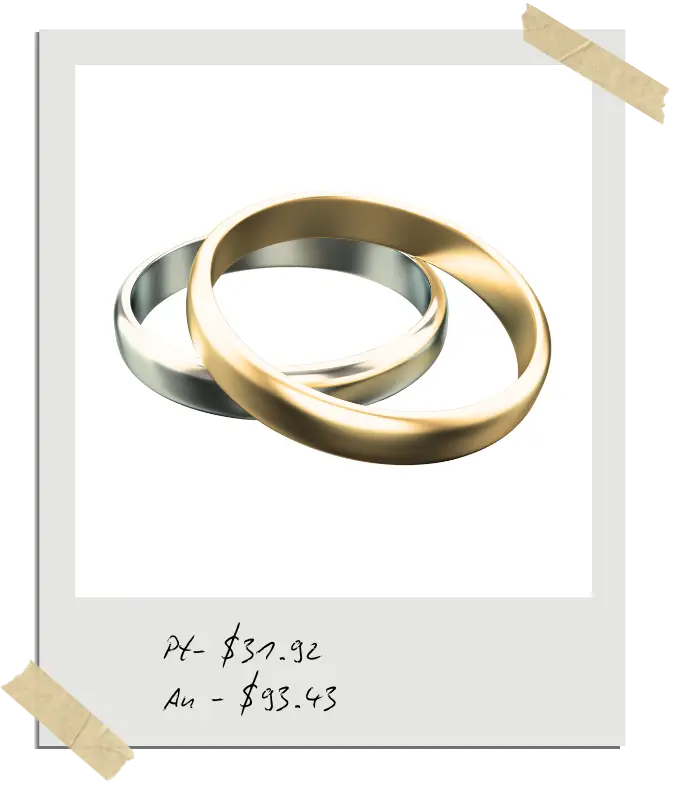
When selecting fine jewelry, the metal you choose is as crucial as the gemstone it showcases. The metal impacts durability, wearability, maintenance, and skin sensitivity. At Adamas Studio, we exclusively use nickel-free metals, ensuring each piece is safe, comfortable, and hypoallergenic.
Metals have been central to jewelry design for millennia. Gold has symbolized wealth and love across cultures, from ancient Egyptian wedding bands to Indian bridal adornments. Platinum gained prominence during the Art Deco era of the 1920s-30s, epitomizing modern elegance. Sterling silver was prevalent in Victorian and Edwardian bridal jewelry, though its tendency to tarnish led to a preference for gold and platinum. Today, white gold dominates engagement ring choices, while rose gold experienced a resurgence in the 2010s, appealing to those with a penchant for vintage-inspired aesthetics.
Choosing the ideal metal involves understanding its properties, historical significance, and current market trends. Let’s delve into the details.
1. Gold (10K, 14K, 18K, 22K, 24K) #
Gold has been cherished in jewelry for over 6,000 years, from Mesopotamian artifacts to Roman adornments. Its resistance to tarnish and lustrous appearance make it a perennial favorite. However, pure gold (24K) is too soft for everyday wear, necessitating the creation of alloys—mixtures with other metals—to enhance strength and durability.
Gold Alloy Composition & Global Variations
Each karat denotes the purity of gold, with the remainder consisting of alloyed metals:
-
24K: 99.9% gold (pure)
-
22K: 91.7% gold, 8.3% alloy (typically copper and silver)
-
18K: 75% gold, 25% alloy (combinations of silver, copper, or palladium)
-
14K: 58.3% gold, 41.7% alloy
-
10K: 41.7% gold, 58.3% alloy
The choice of alloying metals influences the gold’s color and properties:
-
Yellow Gold: Alloyed with silver and copper to maintain its classic warm hue.
-
White Gold: Mixed with palladium, platinum, or silver to achieve a silvery tone. Historically, nickel was used, but due to allergy concerns, reputable jewelers now avoid it.
-
Rose Gold: Contains a higher copper content, imparting a distinctive pinkish-red shade.
Regional Differences in Gold Alloys
Cultural preferences and regulations lead to variations in gold alloys across regions:
-
Europe: Prefers alloys with palladium for white gold, minimizing nickel usage (common in countries like Germany, Italy, and France).
-
Asia & Middle East: Favor higher karat gold (22K and 24K), often alloyed with copper or silver to retain a rich golden color.
-
North America (U.S. & Canada): Commonly uses 10K, 14K, and 18K gold. While nickel was once prevalent in white gold alloys, there’s a shift towards nickel-free compositions.
-
Russia & Eastern Europe: Alloys often have increased copper content, resulting in a warmer, reddish hue, especially in lower-karat gold.
Understanding these differences is vital, particularly when purchasing jewelry internationally or commissioning custom pieces. Always verify the alloy composition to ensure it’s nickel-free and hypoallergenic.
Gold Types Breakdown
10K Gold (41.7% Gold, 58.3% Alloy)
-
Best for: Budget-conscious buyers seeking durable everyday jewelry.
-
Pros:
-
Highest durability among gold types due to substantial alloy content.
-
More affordable option for fine jewelry.
-
Resistant to bending and scratching.
-
-
Cons:
-
Lowest gold content, making it less valuable than higher karats.
-
Less vibrant color; appears paler in yellow gold and duller in white gold.
-
Our Take: While 10K gold offers durability and affordability, it lacks the rich color associated with higher-karat gold. It’s suitable for everyday pieces like earrings or minimalist bands but may not provide the desired luster for engagement rings.
14K Gold (58.3% Gold, 41.7% Alloy)
-
Best for: Engagement rings, wedding bands, and fine jewelry.
-
Pros:
-
Balances durability with gold content.
-
Richer color compared to 10K gold.
-
Widely used in bridal jewelry.
-
-
Cons:
-
Slightly less vibrant than 18K gold.
-
White gold variants require rhodium plating for a bright white finish.
-
Our Take: 14K gold is a popular choice for engagement rings, offering a harmonious blend of beauty, durability, and affordability.
18K Gold (75% Gold, 25% Alloy)
-
Best for: Luxury engagement rings and heirloom pieces.
-
Pros:
-
Deep, luxurious gold color.
-
Higher intrinsic value.
-
Naturally hypoallergenic.
-
-
Cons:
-
Softer than 14K gold, making it more susceptible to scratches.
-
Higher price point.
-
Our Take: For those desiring a rich gold hue and are willing to invest in maintenance, 18K gold provides an opulent appearance ideal for special pieces.
22K & 24K Gold (91.7% – 99.9% Gold)
-
Best for: Investment pieces and cultural jewelry.
-
Pros:
-
Richest gold color.
-
Hypoallergenic and resistant to tarnish.
-
-
Cons:
-
Extremely soft, prone to scratches and deformation.
-
Premium cost.
-
Our Take: While visually stunning, 22K and 24K gold are too soft for daily wear, making them better suited for ceremonial or investment purposes.
Rhodium Plating in White Gold
White gold inherently possesses a slight yellow or gray tint due to its alloy composition. To achieve a bright, platinum-like appearance, white gold is often plated with rhodium, a rare metal in the platinum family.
-
Pros:
-
Provides a lustrous white finish.
-
Enhances scratch resistance.
-
-
Cons:
-
The plating wears off over time, typically requiring reapplication every 1-2 years.
-
Adds to maintenance costs.
-
Our Take: If you prefer a white metal that maintains its hue without periodic upkeep, platinum is a superior choice. However, if you’re comfortable with occasional maintenance, white gold offers a beautiful and cost-effective alternative.
2. Platinum (95% Platinum, 5% Alloy) #
Platinum has long been associated with luxury and exclusivity. Once the dominant metal in early 20th-century engagement rings, its natural white sheen and durability make it a highly sought-after option for fine jewelry.
-
Pros:
-
Naturally white—no rhodium plating required.
-
Highly durable and resistant to wear.
-
Hypoallergenic (ideal for sensitive skin).
-
-
Cons:
-
More expensive than 18K gold.
-
Denser and heavier than gold, which some wearers may find less comfortable.
-
Our Take: Platinum is the ultimate luxury metal. If you want a forever-white ring that won’t fade or scratch easily, it’s worth the investment.
Platinum vs. Gold: Buffing Out Scratches
-
Platinum: Scratches in platinum displace metal rather than remove it. Over time, platinum develops a patina, which some people love for its antique aesthetic. Buffing restores its surface without thinning.
-
Gold: Scratches in gold remove small amounts of metal, making it gradually thinner over time when polished frequently.
This means platinum jewelry retains more metal over time, while gold requires more careful maintenance to prevent excessive thinning.
3. Sterling Silver (92.5% Silver, 7.5% Alloy) #
Silver was once the primary metal in fine jewelry, especially in Victorian and Edwardian eras, but its tendency to tarnish made gold and platinum more desirable. However, with rising gold prices, sterling silver has become a more attractive option for those looking for high-quality jewelry at a lower price.
-
Pros:
-
Affordable alternative to white gold or platinum.
-
Bright, cool-toned appearance with a high luster.
-
Widely available and easy to polish.
-
-
Cons:
-
Prone to tarnishing (requires regular polishing).
-
Softer than gold or platinum, making it less durable for daily wear.
-
Our Take: Sterling silver is great for fashion jewelry, earrings, and special occasion pieces, but it’s not ideal for engagement rings unless reinforced with a protective alloy.
Silver vs. Gold: Cost Comparison (2024-2025)
-
Silver Prices (February 2025): Remain relatively stable between $23–$25 per ounce.
-
Gold Prices (February 2025): Have increased nearly 10% year-over-year, now averaging $2,050 per ounce.
For those looking to invest in fine jewelry, sterling silver offers an affordable alternative to white gold, especially for statement pieces or everyday wear jewelry.
4. Alternative Metals (Titanium, Tungsten, and More) #
In recent years, alternative metals have gained traction in men’s wedding bands and modern jewelry designs. These metals offer unique properties such as extreme durability, lightweight comfort, and hypoallergenic qualities.
Titanium
-
Pros:
-
Lightweight and incredibly strong.
-
Hypoallergenic—great for sensitive skin.
-
Modern, sleek appearance.
-
-
Cons:
-
Cannot be resized.
-
Tungsten
-
Pros:
-
Extremely scratch-resistant—one of the hardest metals available.
-
Affordable alternative to platinum.
-
-
Cons:
-
Brittle—can crack if dropped.
-
Cannot be resized.
-
Our Take: Alternative metals are excellent for modern, minimalist styles, particularly in men’s wedding bands. However, if you anticipate needing a ring resized in the future, gold or platinum are better choices.
5. Metal Stamping & Its Importance #
Every fine jewelry piece should have a metal hallmark stamped inside the band. These stamps indicate metal purity and help prevent fraud – this is a legal requirement in the UK.
Common Metal Stamps:
-
10K, 14K, 18K, 22K, 24K → Gold purity.
-
Pt 950, 900, or Plat → Platinum content.
-
925 → Sterling silver.
Why It Matters:
-
Ensures authenticity—prevents misrepresented metals.
-
Verifies gold and platinum content—important for resale and appraisals.
-
Prevents allergic reactions—allows wearers to confirm metal composition.
Always check the stamping inside a ring when purchasing fine jewelry!
Final Thoughts: Choosing the Right Metal
Your choice of metal depends on budget, lifestyle, and personal style.
-
Gold remains the standard for bridal jewelry and investment pieces.
-
Platinum is ideal for those wanting a durable, naturally white metal that won’t require maintenance.
-
Sterling silver is an affordable, high-quality alternative to white gold, though it requires more upkeep.
-
Alternative metals are great for modern styles but may not be resizable.


